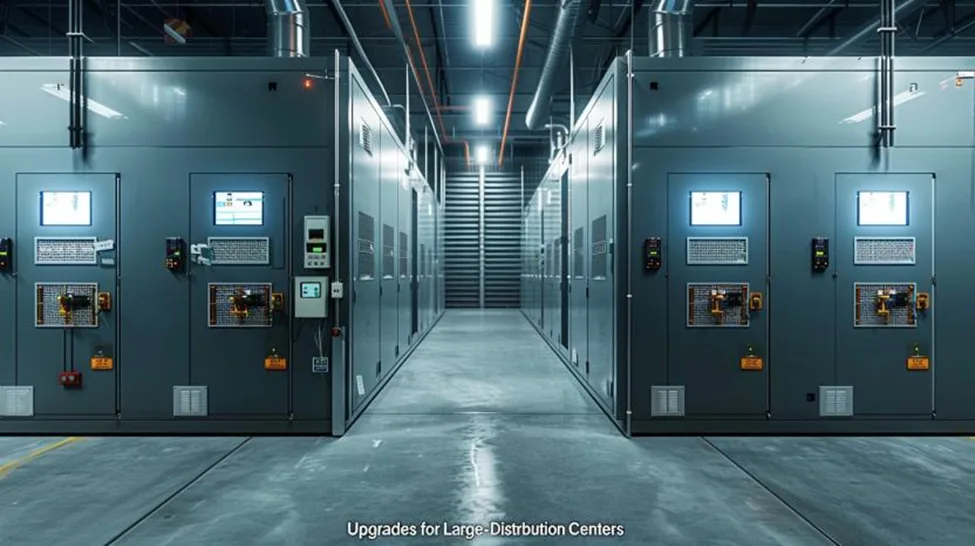Electrical Upgrades for Mass Distribution Centres in Indianapolis
Key Takeaways
- Distribution centers rely on a robust electrical system to enable around the clock operation, reduced equipment loads, and increasing automation requirements.
- A strategic electrical upgrade helps reduce downtime, lowers energy spend and enhances safety across large operation spaces.
- Many industrial facilities are still based on outmoded electrical parts, which introduce the risks of outages and limit the ability to scale.
- Modernizing your electrical infrastructure lays the foundation for long term growth and reliability of power.
I have been through many distribution centers over the years and one thing always stands out first, the hum of equipment before anyone says a word. You feel the electrical system behind every single conveyor, every single charging station, every single rack of controls.
It is great when everything is working? So it’s not so great when a breaker trips at high shipping hours, especially when dozens of folks are depending on that line be active. Once I had a maintenance lead tap along with his knuckle on a panel, almost like knocking on wood, and he said, maybe it holds today. That is usually the time you know that an upgrade is overdue.
Distribution centers grow fast, sometimes faster than their electrical loads ever were designed for. You throw in conveyors, scanners, automation, lighting systems, heating, ventilation and air conditioning equipment, and so on.
Suddenly circuits which previously carried mild demand are at their limits. The strain builds quietly. And then one day you get an outage at the worst moment. I remember talking to a manager whose input processing was down for two hours during the peak holiday time, and he said he thought the cost of having to wait was more than the upgrade they put off for years. He still makes jokes about it, but does not do so with a smile.
Why Large Scale Distribution Centers Require Enhancement with Electricity
Many commercial building owners assume that the electrical infrastructure of the building will last forever. In reality, outdated systems make even the most operating warehouse unpredictable. Older wiring, overloaded circuits, old electrical panels, outdated electrical components and poor switchgear pose safety hazards which no facility should overlook.
I think people underestimate the speed with which the environments of industry change. Once upon a time ten years ago, a centre might have had a limited amount of equipment. Today, you could have automated forklifts, pick to light, high density sorters, heavy chargers, enhanced inventory robots, and improved lighting systems. That is a lot of demand. And if your electrical system has not caught up, inefficiency creeps in. Equipment strains. Breakers trip. You get early warning signs long before failure. Most people shrug and move on, but you get a little uneasy stuff goes flicking.
Modern electrical improvements can help balance distribution of power, manage demand, and provide safer working conditions. They also help you meet such standards as the National Electrical Code, or NEC, which changes over time to reflect new technology. The better your infrastructure the easier it is to expand based without worry. Scalability is not only a buzz word, it is actual relief for facilities that continue to grow.
Key Areas Where Upgrades Make the Biggest Impact
Service Entry, Transformers and Switchgear
When you are modernizing your electrical foundation you found your beginning at the service entry. Improved transformers and switchgear enhance higher electrical loads and help the power system spread more evenly throughout your building. It is not unusual for industrial facilities to be operating with decades old equipment. I do recall looking at a panel label from 1994 and saying to myself, maybe it is time to retire that unit.
Upgraded switchgear provides better fault protection, outage reduction and advanced diagnostics. It is the type of change you do not see day to day, but you feel it when you are more stable in your operations. A study by NREL for non-refrigerated warehouses highlights that electrical infrastructure upgrades yield major savings and resilience improvements when properly integrated.
Electrical Panels, Breakers and Circuits
Electrical panels house the central of your facility’s circuits. When they get older, you begin to see the little problems. A breaker that heats a little bit more than it used to. A circuit for which the new automation equipment is too much These issues are slow growing, and suddenly, they are inevitable.
Newer electrical panels are able to handle the higher demand, work in conjunction with modern circuit breakers, and eliminate the potential for safety hazards. You also have better organization inside the panel, which aids in inspection or troubleshooting. Modernization in this area does produce immediate operational improvements.
Backup Power, Generators and Resilience
Every distribution center requires a generator strategy. A single outage can pile delays on top of one another and keep them going for days. More than once I have watched managers on edge reading the control screen over and over again during a storm.
With more robust electrical infrastructure, your generator is faster to respond, your transfer switch is smooth and your backup power solutions keep the floor running.
Smart Controls, Monitoring and Automation
Automation is everywhere at present. And to be able to install automation in a safe way, you need the right electrical upgrade behind it. Smart meters, monitoring devices, and remote diagnostics make it possible to catch problems before they go down on a line.
Some managers have told me that the real time data changed their building management. It is one thing to make a guess about where inefficiency can come from. It is one thing to see where exactly a circuit struggles,
Improving The Energy Efficiency
Energy efficient equipment, sensors, optimized lighting systems, and HVAC upgrades all rely on having a good electrical system. When the base system is outdated, even the best energy efficient improvements will not do the job. A strong electrical upgrade provides every additional improvement room to work.
Working With the Right Stupid
At some point during a project, someone usually asks the question, do we really need outside help for this, or can we do it ourselves. Technically, you can do part of it in house, but for a big electrical overhaul you need someone working with commercial electrical projects on a daily basis.
This is where a good crew comes into play, especially if you are thinking about hiring an electrical contractor in Indianapolis as part of your overall project planning. Local teams are familiar with the utilities, requirements on the regional side and the practical challenges in commercial building upgrades. When you have experts integrated into it from the beginning, you won’t have to redesign work halfway through.
A good partner will address your electrical infrastructure, researching your electrical loads, ensuring NEC compliance, and will lead your modernization plan. They help you to understand the gaps that you missed, and sometimes, they bring up issues you did not know existed. It feels reassuring, even if it complicates the project in the beginning.
Compliance and Code Requirements
Distribution centers are required to comply with NEC standards and the codes of the area in which they are built. That means making sure your wiring, power distribution and electrical safety procedures are up to date with the current regulations. Older commercial building facilities often slip out of compliance without even realizing it, if previous teams made quick fixes and there is no documentation of them.
A full inspection determines antiquated systems, damaged parts, stressed circuits, and places where safety hazards begin to take shape. When your process of upgrading electricity involves appropriate documentation and checking codes, then you are protecting your operational workflow from unnecessary risk.
Reducing Downtime, Outages and Inefficiency
No one wants downtime. I have seen whole shipping lines shut down because one circuit breaker went down. People underestimate how much little inefficiencies cost. A flicker in lighting affects scanners. A voltage dip slows automation down. Even a short circuit can destabilize more than one zone. According to the DOE’s O&M Best Practices Guide, integrating regular diagnostics and upgrade planning can reduce energy use and downtime by 5-20% in commercial buildings.
When you modernize your electrical system you reduce these risks enormously. Stronger wiring, new improved breakers, and reinforced electrical panels provide you with a stable electrical power source that can power anything you want from conveying, heating and cooling HVAC and automated systems. Socialization, the goal is simple, Less surprises, More stability.
Planning Your Upgrade
You do not have to overhaul everything at one time. You can upgrade your electrical infrastructure with minimal impact on the business, one area at a time, and beginning with the areas where the risk is greatest. Most facility leaders start with service entry equipment, followed by panels, followed by load management systems.
A step by step plan generally includes:
• Evaluation and inspection
• Electrical load study
• Upgrade design
• Panel and circuit improvements
• Generator integration
• Monitoring and diagnostics set up
• Final commissioning
It takes coordination, patience and maybe a temporary inconvenience or two. But the payoff in operational reliability is great.
Final Thoughts
Distribution centers are more dependent on a good electrical infrastructure than ever before. Growing automation, heavier equipment and bigger operations make for a reliable system. When you make an investment for electrical update, you are safeguarding your staff, your workflow, and your potential to grow without interruption.
A modern electrical system offers you stability, lower energy costs and limited outage risks. And when you strategically plan your upgrades, you create a facility that is prepared for future demand.






